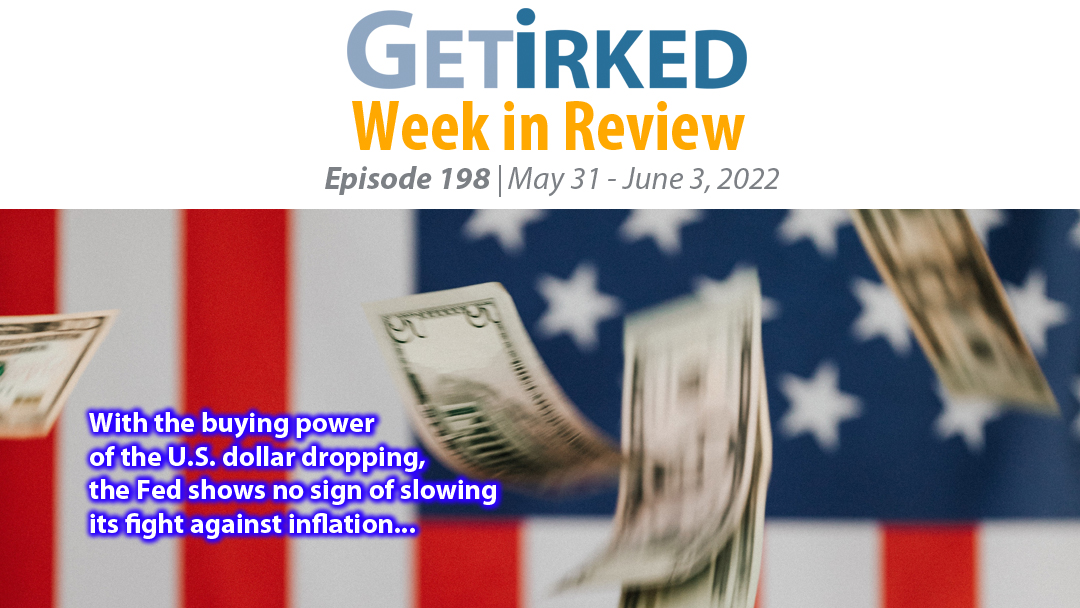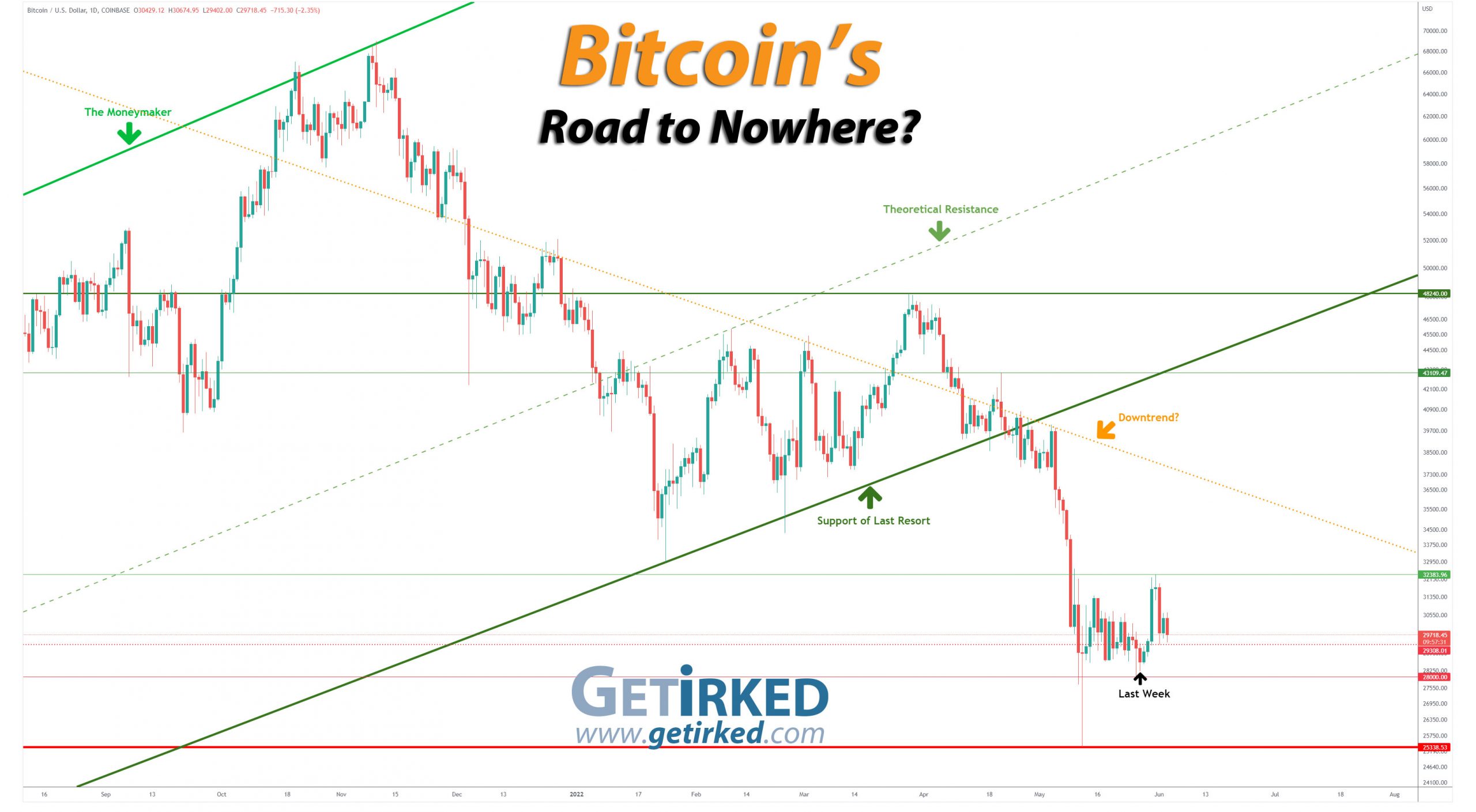Summing Up The Week
Following last week’s epic rally off the lows, the market took a breather this week to retreat with the Fed doubling-down on its fight against inflation and a variety of other economic news showing that all is not well in the U.S. economy.
Let’s take a look at the news that moved the markets this week…
Market News
OPEC+ considering suspending Russia from deal
Oil prices spiked following a Wall Street Journal report which cited unnamed OPEC delegates claiming OPEC+ is considering whether to suspend Russia from an oil production deal, reported CNBC.
Earlier in the week, the European Union (EU) announced plans to stop using Russian oil (however, it continues to use Russian natural gas), and, on Wednesday, the Journal reported that OPEC delegates are concerned about growing economic pressure on Russia and its ability to pump more crude to cool soaring prices.
While oil prices spiked throughout the week, the markets did not react to the news on Wednesday, heading higher in morning trading following the report. The market did roll over later on Wednesday, however that was due more to fears of economic conditions and, surprisingly, not the OPEC deal.
Fed Vice Chair Brainard says no case to pause hikes
In an interview with CNBC’s Squawk on the Street on Thursday, Federal Reserve Vice Chairperson Lael Brainard says she sees no case for the Fed to pause rate hikes, reported CNBC.
To the uninitiated, the Fed only has two tools to fight inflation – reduction of its balance sheet and interest rate hikes. However, the Fed has a third tool – media appearances, also referred to, somewhat cynically, as “jawboning.”
Brainard is known as the most dovish of the Federal Reserve Bank members, so when she comes out with hawkish comments, the market tends to listen. Whereas up until Thursday, many stock pundits believed the weakening economic indicators might cause the Fed to pause its interest rate hikes, having the most dovish member come out and say the hikes are still coming caused consternation in the markets.
Jobs increased 390K, better than expected
The environment remains firmly planted in the “good news is bad news” camp as Friday’s nonfarm payrolls report showed jobs increased 390,000 in May versus the 328,000 estimate from Dow Jones economists, reported CNBC. Unemployment held at 3.6%, slightly above the lowest level since December 1969.
As I’ve discussed before, a strong jobs market is usually a sign of a strong economy, but in the current high-inflation environment, the Federal Reserve is trying to weaken the economy, so signs of economic strength indicate that the Fed must continue down its path of tightening the interest rate and reducing its balance sheet.
Accordingly, the market weakened following the release of the job report on Friday.
Next Week’s Gameplan
While it may seem strange to take seasonal changes into consideration, the market is notoriously volatile over the summer months (June, July, and August) as many traders take vacations which reduces the amount of volume in the markets. With less trading volume, it doesn’t take as much participation to cause wild moves in stocks and indexes, so it’s certainly worth keeping the season in mind.
That being said, the market has been in No Man’s Land this week, floating between Buying Season (where it’s low enough to add to positions) and Selling Season (where it’s high enough to take profits wherever applicable).
Accordingly, the game plan remains the same – make sure to have buying and selling targets just in case volatility returns and opportunities present themselves.
Have a great start to your summer, everyone!
This Week in Play
Stay tuned for this week’s episodes of my two portfolios Investments in Play and Speculation in Play coming online later this weekend!
Crytpo Corner
Important Disclaimer
Get Irked contributors are not professional advisers. Discussions of positions should not be taken as recommendations to buy or sell. All investments carry risk and all readers must accept their own risks. Get Irked recommends anyone interested in investing or trading any asset class consult with a professional investment adviser to determine if an investment idea is suitable to them and their investment goals.
Bitcoin Price (in USD)
%
Weekly Change
Bitcoin Price Action
Another Bitcoin Pop-and-Drop
Bitcoin saw a decent pop over the Memorial Day holiday weekend, breaking through the previous monthly high of $31,418.35 before finding resistance at its new high of $32,383.96 and pulling back pretty substantially to set a new higher weekly low at $29,308.01 on Wednesday.
The crypto’s next big move will be determined by which point it breaks through first, its new high, or its now monthly low of $28,000 (followed by its 2022 low of $25,338.53).
The Bullish Case
Bulls point to the strong pop over the holiday weekend as a sign that institutions and retail investors are buying the dip. Many bullish analysts are considering the drop to $25,338.53 a one-time, rare occurrence, with most predicting much higher-highs in store for Bitcoin.
The Bearish Case
As it has been for the past few weeks, Bears maintain the upper hand as Bitcoin remains in a very bearish macrot trend, far below the Downtrend? line that’s been in place for weeks, if not months, now. News became particularly bad following reports that Gemini, one of the leading crypto brokers (and my preferred broker in the space) announced that Bitcoin is in a crypto winter and that they would be cutting 10% of its staff, as reported by CNBC on Thursday.
Bitcoin Trade Update
Current Allocation: 5.128% (-2.866% since last update)
Current Per-Coin Price: $30,295.68 (-1.264% since last update)
Current Profit/Loss Status: -1.905% (+3.179% since last update)
When Bitcoin popped over the Memorial Day holiday, it crossed over my per-coin cost which meant that, once again, it was time for me to take profits to reduce the size of the position. I made a few sells throughout the week which gave me an average selling price of $31,290.64 (after fees) and reduced my per-coin cost -1.264% from $30,683.55 down to $30,295.68.
While the profits I took weren’t significant in terms of percentage gains, the purpose of the sales was to reduce my overall allocation -2.866% from 7.994% to 5.128%.
since Bitcoin remains in a long-term bearish macro trend with even bullish analysts who are predicting a potential pop to $36K seeing no catalysts in the short term which would indicate further upside from there. Pile on to all this negativity the Bears who believe Bitcoin’s target is $20K, at least, is in the future, and it was prudent to reduce my size.
Bitcoin Buying Targets
Using Moving Averages and supporting trend-lines as guides, here is my plan for my next ten (10) buying quantities and prices:
0.721% @ $25,910
4.029% @ $23,757
7.477% @ $21,425
7.768% @ $20,120
2.144% @ $18,057
2.214% @ $16,919
2.530% @ $14,007
2.846% @ $11,765
3.163% @ $10,474
3.479% @ $9,177
No price target is unrealistic in the cryptocurrency space – Bullish or Bearish.
While traditional stock market investors and traders may think the price targets in the cryptocurrency space are outlandish due to the incredible spread (sometimes a drop of near -90% or a gain of up to +1000% or more), Bitcoin has demonstrated that, more than any speculative asset, its price is capable of doing anything.
Here are some of Bitcoin’s price movements over the past couple of years:
- In 2017, Bitcoin rose +2,707% from its January low of $734.64 to make an all-time high of $19,891.99 in December.
- Then, Bitcoin crashed nearly -85% from its high to a December 2018 low of $3128.89.
- In the first half of 2019, Bitcoin rallied +343% to $13,868.44.
- In December 2019, Bitcoin crashed -54% to a low of $6430.00 in December 2019.
- In February 2020, Bitcoin rallied +64% to $10,522.51.
- In March 2020, Bitcoin crashed nearly -63% to a low of $3858.00, mostly in 24 hours.
- Then, Bitcoin rallied +988% to a new all-time high of $41,986.37 in January 2021.
- Later in January, Bitcoin dropped -32% to a low of $28,732.00.
- In February 2021, Bitcoin rallied +103% to a new all-time high of $58,367.00.
- Later in February, Bitcoin dropped -26% to a low of $43,016.00.
- In April 2021, Bitcoin rallied +51% to a new all-time high of $64,896.75.
- In June 2021, Bitcoin crashed -56% to a low of $28,800.00.
- In November 2021, Bitcoin rallied +140% to a new all-time high of $69,000.00.
- In May 2022, Bitcoin crashed -63% to a low of $25,338.53.
Where will Bitcoin go from here? Truly, anything is possible…
What if Bitcoin’s headed to zero?
The only reason I speculate in the cryptocurrency space is I truly believe Bitcoin isn’t headed to zero.
I am prepared for that possibility, however, by knowing I could potentially lose all of the capital I’ve allocated to this speculative investment. Professional advisers recommend speculating with no more than 5% of an investor’s overall assets. Personally, I’ve allocated less than that to speculating in crypto.
I feel that anyone who doesn’t fully believe in the long-term viability of cryptocurrency would be better served not speculating in the space.
On a good day, this asset class isn’t suitable for those with weak stomachs. On volatile days, the sector can induce nausea in the most iron-willed speculator. If a speculator isn’t confident in the space, the moves will cause mistakes to be made.
Ways to give back to GetIrked:
Send me a tip via Stripe! Thank you!
Get free money by signing up for an account with my referral link for Schwab
Sign up for Gemini and we each get $10
Click this referral link to get the Brave Browser
If you use Brave, you can also use the Tip function to tip me in Basic Attention Token (BAT).
Suicide Hotline – You Are Not Alone
Studies show that economic recessions cause an increase in suicide, especially when combined with thoughts of loneliness and anxiety.
If you or someone you know are having thoughts of suicide or self-harm, please contact the National Suicide Prevention Lifeline by visiting www.suicidepreventionlifeline.org or calling 1-800-273-TALK.
The hotline is open 24 hours a day, 7 days a week.


